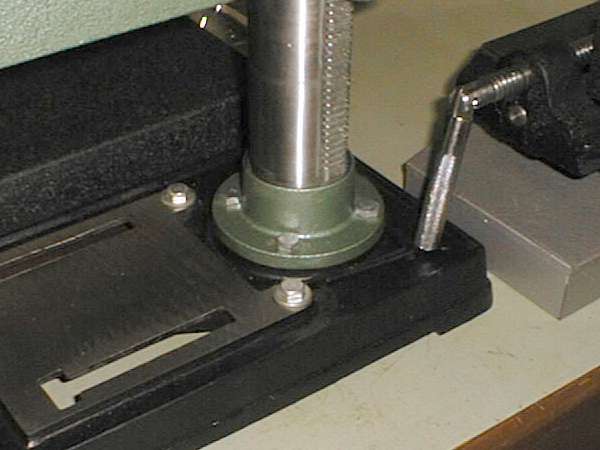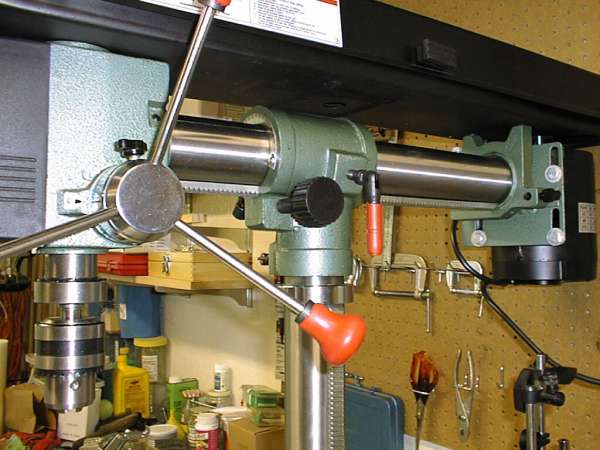The Grizzly Radial Drill Press Review
A Light Duty 34" Drill Press
John D. UptonJuly 15, 1999

If you have a need to drill to the center of large work pieces, or drill holes at odd angles, perhaps this tool will fit your needs. A radial drill press allows you to change the spindle-to-column distance and tilt both the spindle and table for those odd drilling jobs. Here is a relatively inexpensive shop tool that I am beginning to like a lot.
When I needed a way to core drill the 17.5 inch primary mirror for a telescope project, I began looking at tools to help with the task. A friend has a Sears Craftsman Radial Drill Press, so I had been aware of their capability. In addition, I was familiar with Radial Mill-Drills from seeing them in machine tool catalogs. I would love to have one of these Radial Mill-Drills, but could not justify the cost (ranging from $900 to $9,000 US) and don't really have the shop space for another major tool like that. That put me back looking at the Sears unit.

I began watching for a sale on the radial drill press, as Sears sometimes puts their larger tools on sale for 20% to 30% off list price. I had been watching the sales flyers for a few months to no avail. When I needed some additional tooling for my Lathe-Mill-Drill machine, I ordered from Grizzly Industrial. When the order arrived, they had included a new catalog. Lo and behold, in this catalog was listed a new item -- a 34 inch radial drill press. The price was listed as $199 plus $40 shipping. This was attractive since the Sears model was priced at $289 plus shipping. The photograph looked almost the same as the Sears model.
I finally ordered the Grizzly unit after seeing it go on sale for $139 plus $40 shipping on their Web site. At that price, the deal was irresistible to me. As expected, the demand was high and the unit was back ordered for four weeks. They actually shipped ahead of schedule though, after only three weeks and the unit took eight days to arrive.
I ordered the bench model of the Radial Drill Press. It weighs about 100 pounds. Assembly only took me about an hour. Overall, the fit and finish is pretty good, even considering that this is an imported machine. Once I had the machine, I compared the parts to the photographs in the Sears catalog. It is the basically the same machine. The castings are all identical. The only differences seem to be the plastic bezel on the front of the drill head which carries the name plate and switch, the various stickers which also carry the manufacturer's name, and possibly the motor.

I noted one problem during assembly of the unit. The corners of the hex head bolts which hold the column mounting flange to the bench base casting rub on the flange casting while tightening. The holes for these are too close to the column. You must be careful to get them tight even though the corners of the hex bolt head rub against the casting at each turn. Because of this, you must use an open-end wrench here. A better solution might be to replace the hex bolts with socket head cap bolts. Then you can use an (Allen) hex wrench to tighten the assembly down.
I also noted something else during assembly that calls for a word of caution. The whole drill head and radial adjustment assembly just sits on top of the vertical column and only engages by an inch or so. It is pretty much held in place by gravity. There is a locking clamp that secures it during normal operation. It would be wise to move the drill head to a more centered, balanced position prior to attempting to swing the assembly sideways. Having the spindle at either extreme while turning the unit may cause it to topple off the column if care is not taken.

The next step was to install the machine on my workbench. This went without any major problems. I did discover that I had not done enough planning, though. My workbench, while 30 inches wide (from the front of the bench to the wall behind), it isn't quite big enough. I needed about 1.5 inches more space at the back of my bench than I had. As a consequence, even after mounting the drill press at the very front of my bench, the spindle is still about 0.5 inches from the center hole in the table. When moving the drill head and spindle radially back and forth, the motor and belt housing hit the wall while the drill head still has more than two inches of travel remaining. My bench should have been either a few inches wider or not pushed all way against the wall. It's close enough for me to live with as it is, though. I would recommend having a 36 inch wide bench for installation.
After getting the drill press assembled and bolted onto my bench, I took a few measurements to get a feel for the overall quality of construction. I was quite pleased by the results. I put a length of 0.375 inch diameter drill rod in the chuck and clamped a dial indicator to the drill press table. I first measured the run-out of the spindle while rotating it by hand. The results showed a pretty respectable +/- 0.0015 inch measurement with the quill completely retracted. With the quill fully extended to its 3.25 inch length, the spindle rotational run-out was the same. With the quill in this fully extended position, quill movement of 0.012 inches could be detected by pushing it back and forth. This is not enough to cause me any problems for normal drilling jobs. I may have to account for it when I core drill my mirror, however. I also checked the spindle and table for squareness. Surprisingly, all error measurements were either too small to worry about or too small to measure.
Most of the controls for the drill press work as expected. The motor is quiet and runs smoothly. All the various locking handles work easily and have a soft rubber grip. The radial adjustment for the drill head works well and is easy to adjust. The tilt adjustment for the head, however, is a bit tight, especially near the extremes of adjustment 45 degrees to the left and 90 degrees to the right. The down-feed works very smoothly, although the return spring makes funny sounds as it relaxes. I don't care too much for the down-feed depth adjustment, but it works repeatably. The height adjustment of the table, on the other hand, doesn't work nearly as well as everything else. In fact, it's bad. I'm accustomed to table lift controls that don't work well, but this one is worst than usual. It takes a lot of help and coaxing to get the table height changed. Luckily, you shouldn't have to do this too often unless you are drilling several parts of widely varying thicknesses. The tilt adjustment for the table is very basic but works well. It is adjusted by loosening a bolt under the table, tilting to the desired angle and then clamping in place again by re-tightening the bolt. It is simple but effective.
Radial Drill Presses are handy if you have work to do on large parts. There are pitfalls that first must be considered. First of all, note that they are rather large and bulky. They will take up much more of your bench space than a normal drill press. Secondly, they are not built like a Radial Mill-Drill -- don't expect absolute rigidity when the spindle is run out to its maximum of 17 inches from the column. Additionally, these are not heavy duty machines. They come with a 0.5 to 0.75 horsepower motor. Finally, the table is a fixed and limited size. If you do want to drill a large part, you must make a table extension of some sort or swing the unit sideways and build a riser directly onto your workbench to support the work. If you can work within these limitations and have the space, I feel this is a good addition to the home shop.
I am satisfied with my purchase of the Grizzly 34" Bench Radial Drill Press. Considering the cost, I feel I've received good value for my money. One added benefit of this model is that even though it is an imported machine mail ordered from a distant dealer, the fact that Sears sells the same unit ensures that I have a ready source for replacement parts if ever required. (This is not to downplay the reputation of Grizzly Industrial. I've received excellent service and good quality products from them. I just think the availability of parts through a local store is an additional advantage.)